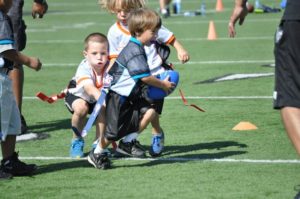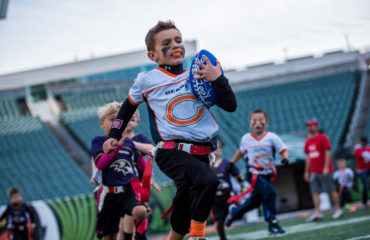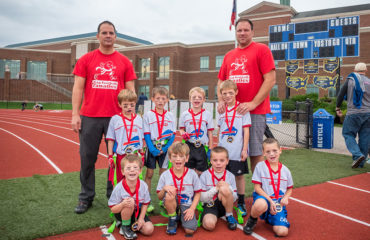How To Coach 3-4 Year Olds
 As I have been doing Hustle & Attitude flag football coaching clinics over the last couple of years, I have frequently been asked how to coach 3-4 year olds. My clinics have provided tips and techniques for dealing with kids, managing practices and games, and dealing with parents that tend to be geared to the older age divisions. Recognizing this gap in my clinics and being a fan of the ‘for Dummies’ books, I read Child Psychology and Development for Dummies by Dr. Laura Smith and Dr. Charles Elliott and Coaching Kids for Dummies by Rick Wolff seeking ideas. The recommendations below are gleaned from tips from those two books and my personal experience coaching 3-5 year-olds.
As I have been doing Hustle & Attitude flag football coaching clinics over the last couple of years, I have frequently been asked how to coach 3-4 year olds. My clinics have provided tips and techniques for dealing with kids, managing practices and games, and dealing with parents that tend to be geared to the older age divisions. Recognizing this gap in my clinics and being a fan of the ‘for Dummies’ books, I read Child Psychology and Development for Dummies by Dr. Laura Smith and Dr. Charles Elliott and Coaching Kids for Dummies by Rick Wolff seeking ideas. The recommendations below are gleaned from tips from those two books and my personal experience coaching 3-5 year-olds.This age group is different from the older kids you might coach or have coached. Be mindful that children aged 4-5 rarely have the cognitive ability to understand the most fundamental strategies or even the rules of the sport. Breaking out complicated offensive plays and expecting these kids to understand would be inappropriate. Just convincing them to run the right direction when the other team is trying to pull their flag is a success. As Wolff points out, most of the kids at this age are just happy to be wearing a uniform, to be a member of a team with their friends, and to be running around and having a good time. Coaches at this level should emphasize that flag football is fun. They can do this by having the right expectations and deal with the kids appropriately.
Expectations of Kids This Age
Much of a coach’s ability to ensure a successful season for kids this age hinges on expectation management. Specifically, coaches should expect the following behaviors from kids this age:
- Kids make errors…lots of them. Understanding this, a coach shouldn’t be surprised or upset when the players make lots of mistakes. Kids at this age may run the ball in the wrong direction when challenged by a defender attempting to pull their flag. Gently explain to the young athlete that the idea is to try to run the ball towards the other end of the field…to score a touchdown. Be excited when you say touchdown so that the kids begin to understand that scoring a touchdown is a good thing.
- Kids cry. They may cry when they fall down or get hurt or don’t score a touchdown. Comfort the athlete and let them cry it out. Explain to them what happened and why it is OK. Maybe remove them from the practice or game until they are finished.
- Some kids play in the dirt – while on the field. Remember, kids have relatively short attentions spans and you need to adapt to theirs, not the other way around. Keep practices and games engaging for the kids so they have less opportunity to lose attention on what you are teaching or showing them.
- Kids are supposed to be kids. They are not little adults or even smaller high schoolers. This is the youngest division in the league and these kids are getting their first exposure to flag football, if not to team sports.
In flag football, understand that the pre-K division is intended to introduce the basics of the game and is above all else about the kids having fun. Fun comes both in the repetitive attempts and ultimately, in the successful completion or partial completion of the tasks involved in playing flag football. (Follow this link to a video of the ‘play’ you’ll run on offense.) Coaches can teach these players not to flag guard – the earlier they get out of this habit, the better their flag football careers will go.
Coaches can also teach proper flag pulling techniques. These should be taught using fun drills that can be turned into mini-games themselves. For instance, you can teach the kids to pull flags by setting up a 10 yard by 10 yard square area using cones; place one defender at each corner and the offensive player in the middle of the square; then blow your whistle and have the defensive players attempt to pull the offensive player’s flag. Remember to make sure the kids aren’t standing around – this is a recipe for them to get into trouble – by holding multiple drills at the same time to keep all the players on the team busy.
Additional Recommendations for Coaches
In addition to teaching the players the game, here are some additional recommendations for dealing with children in this age group:
- Make a goal of spending more time being positive than negative. This is the time to establish that children get praised for their efforts, not results. Players should be praised for trying – for hustling and showing the right attitude, regardless of whether they gain positive yards or score touchdowns.
- Teachers and coaches of kids this age have used tried and true techniques like “1-2-3, all eyes on me” to get the young people to pay attention to direction.
- Establish regular routines; children do better when their worlds are reasonably predictable. Practices and games should follow a familiar pattern for the kids. They will be more comfortable if they have an idea what is coming next.
- Give children the freedom to experiment and try different approaches. Just watch how the kids interpret and try to do what you’ve taught or asked them to do. Some of their methods will be crazy – as long as they aren’t hurting anyone, let them go.
- Don’t take a child’s misbehavior personally; defiant behavior is normal, keep your own frustration and anger in check. The key to handling these incidents is not to expect that they won’t happen. There is almost never a good reason to yell at the kids. The kids will disobey and not follow instructions. Be calm and firm in how you deal with it.
- When providing negative feedback to a child, be sure to criticize the unwanted action, not the child.
- Time-outs are particularly effective strategies for teaching kids that misbehavior costs something. Have a separate area for the child to go to. Time-out should only be for a few minutes for children 3-5 years old; preferably no more than five minutes. Give a single, brief explanation for the time-out (ideally less than 10 words).
Coaches of this age group should be focused on introducing the kids to football. Running with the ball, playing catch, chasing players down and pulling their flags (making ‘tackles’) are all going to be new to these kids and the more fun they have learning how to play, the more they will want to play. Hustle & Attitude coaches measure a successful season by whether the kids had fun and decide to come back and play the following season. Keeping the right expectations and following the recommendations above can help a coach in this division ensure a successful season for the players.


